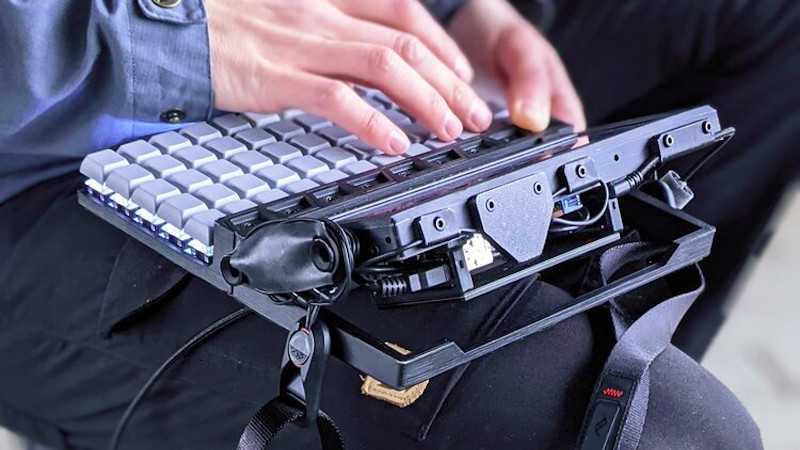Cyberdecks make for interesting projects, some are a bit rough while others are beautiful, but it’s maybe something that even the most ardent enthusiast might agree — these home-made portable computers aren’t always the most convenient to use. Thus we’re very pleased to see this machine from [TRL], as it takes the cyberdeck aesthetic and renders it in a form that looks as though it might be quite practical to use.
It takes a Raspberry Pi and a Waveshare 1280×400 capacitive touch screen, and mounts this combo with a keyboard in an uncommonly well-designed 3D printed chassis. With the screen flat it resembles the venerable TRS-80 Model 100 “slab” computer of the early 1980s, but flip it up, and a surprisingly usable laptop appears. Power comes from an external battery pack with a lead, but this is due more to thermal management issues with PSU boards than it is to necessity. The finishing touch is a stylish custom laptop bag, making for a combo we’d take on the train to bang out Hackaday articles any day.
Looking around, we think perhaps it might give the Clockwork DevTerm a run for its money. Alternatively, you might take a look at this upgraded TRS-80 model 100.
Thanks to [The Kilted Swede] for the tip.

















Tempting, I have lusted after the HX-20, Z88, NC200 etc for many a year, like the idea of a keyboard large enough to use on the hoof, with screen compact enough not to get in the way while doing so.
I’m really digging these cyberdecks with the ultrawide screens. Not the most practical aspect ratio for actual work, but it looks really cool.
Someday someone might replace the innards of an Alphasmart Dana, and run a Palm OS emulator on it to keep it compatible with the Dana and other PalmOS apps, while also running some other OS.
I don’t see any issue with them – as long as they are still tall enough to actually get a fair few lines of text in at a readable size – just treat it as two screens next to each other – room for all the windows… Well not all the windows, I can’t even do that on my giant monitor, but more than one window anyway – the working terminal and the man page of the tool you are using at least, quite possibly with this sort of aspect ratio a video tutorial or web reference as well, its just about wide enough (if the screen and your eyes are good enough anyway)
Depends on the work. If you’re using 2 or 3 terminals it can be pretty nice.
The display should be vertical (like holding a phone).
All the kids take photos and videos this way, so it will be painful watching Tiki-Tokies with a landscape oriented display.
It really needs a touch screen, or better still an ibm trackpoint/touchstyk pointing stick. Can you get those as a module? That would make it really useable.
It has a capacitive touch display.
With this kind of wide display, you could watch 8 Tiki-Tokies videos at the same time, for a maximum productivity :D
At what point is a cyberdeck just a laptop in a Peli case?
Hand-made, not off-the-shelf.
Yeah because its a lot handier than a laptop, especially the blank keyboard and weird aspect ratio of the screen will make it a productive tool
Compared to a similarly tiny and portable ‘laptop’ of the netbook ilk this looks very productive, decent key cap size, large enough screen to actually have some reference material up, still very portable… (though to really rival the commercial offering for getting work done on the move some extra polish in the build is likely needed)
Also who needs legends on the keys to their daily driver computer?!?!! Heck I still find I know where every function key is to the old IBM Thinkpads I never used that much, and haven’t used in years every time I go back to them, and the old Panasonic Toughbooks I largely use in preference now are a very odd layout but no trouble to use… (though the keyboards on them are comparatively rubbish as a typing experience, and I don’t use them much either – laptops are only really needed when you are going to be away from your desk with the much better ergonomics)
Unsure if sarcasm….
But the problem with regular laptop formfactor, is even modern light screens tend to overbalance the laptop over backwards when set at too obtuse an angle. Particularly on canted and uneven surfaces. The older machines, clamshell form, you’ll note often had their heaviest parts set behind the effective screen hinge axis, because screens and their lighting systems were thicker and heavier still, even in relatively modest 8″ diagonals.
Then also humans are good at keeping their body “about the thickness of an arm” away from other objects while moving around, as they soon learn it’s ouchy to trap an arm against a solid object, but anything larger than that protruding out of your personal space is likely to get smashed off things on the regular. So yeah, strap a mass produced machine to your leg if you will, for a “full screen” on the go experience, but it better be an oldschool toughbook or something because that screen is gonna take hits.